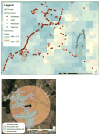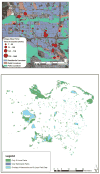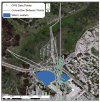"Spatial Energetics": Integrating Data From GPS, Accelerometry, and GIS to Address Obesity and Inactivity
- PMID: 27528538
- PMCID: PMC5067207
- DOI: 10.1016/j.amepre.2016.06.006
"Spatial Energetics": Integrating Data From GPS, Accelerometry, and GIS to Address Obesity and Inactivity
Abstract
To address the current obesity and inactivity epidemics, public health researchers have attempted to identify spatial factors that influence physical inactivity and obesity. Technologic and methodologic developments have led to a revolutionary ability to examine dynamic, high-resolution measures of temporally matched location and behavior data through GPS, accelerometry, and GIS. These advances allow the investigation of spatial energetics, high-spatiotemporal resolution data on location and time-matched energetics, to examine how environmental characteristics, space, and time are linked to activity-related health behaviors with far more robust and detailed data than in previous work. Although the transdisciplinary field of spatial energetics demonstrates promise to provide novel insights on how individuals and populations interact with their environment, there remain significant conceptual, technical, analytical, and ethical challenges stemming from the complex data streams that spatial energetics research generates. First, it is essential to better understand what spatial energetics data represent, the relevant spatial context of analysis for these data, and if spatial energetics can establish causality for development of spatially relevant interventions. Second, there are significant technical problems for analysis of voluminous and complex data that may require development of spatially aware scalable computational infrastructures. Third, the field must come to agreement on appropriate statistical methodologies to account for multiple observations per person. Finally, these challenges must be considered within the context of maintaining participant privacy and security. This article describes gaps in current practice and understanding and suggests solutions to move this promising area of research forward.
Copyright © 2016 American Journal of Preventive Medicine. All rights reserved.
Figures



Similar articles
-
Spatial physical activity patterns among primary school children living in neighbourhoods of varying socioeconomic status: a cross-sectional study using accelerometry and Global Positioning System.BMC Public Health. 2016 Mar 22;16:282. doi: 10.1186/s12889-016-2954-8. BMC Public Health. 2016. PMID: 27000056 Free PMC article.
-
A framework for using GPS data in physical activity and sedentary behavior studies.Exerc Sport Sci Rev. 2015 Jan;43(1):48-56. doi: 10.1249/JES.0000000000000035. Exerc Sport Sci Rev. 2015. PMID: 25390297 Free PMC article.
-
Assessment and statistical modeling of the relationship between remotely sensed aerosol optical depth and PM2.5 in the eastern United States.Res Rep Health Eff Inst. 2012 May;(167):5-83; discussion 85-91. Res Rep Health Eff Inst. 2012. PMID: 22838153
-
Applications of geographic information systems (GIS) data and methods in obesity-related research.Obes Rev. 2017 Apr;18(4):400-411. doi: 10.1111/obr.12495. Epub 2017 Feb 6. Obes Rev. 2017. PMID: 28165656 Review.
-
Spatial Technologies in Obesity Research: Current Applications and Future Promise.Trends Endocrinol Metab. 2019 Mar;30(3):211-223. doi: 10.1016/j.tem.2018.12.003. Epub 2019 Feb 1. Trends Endocrinol Metab. 2019. PMID: 30712979 Review.
Cited by
-
Translational Health Disparities Research in a Data-Rich World.Health Equity. 2019 Nov 8;3(1):588-600. doi: 10.1089/heq.2019.0042. eCollection 2019. Health Equity. 2019. PMID: 31720554 Free PMC article. Review.
-
Comparison of static and dynamic exposures to air pollution, noise, and greenness among seniors living in compact-city environments.Int J Health Geogr. 2023 Jan 28;22(1):3. doi: 10.1186/s12942-023-00325-8. Int J Health Geogr. 2023. PMID: 36709304 Free PMC article.
-
Associations of spatial mobility with sexual risk behaviors among young men who have sex with men in New York City: A global positioning system (GPS) study.Soc Sci Med. 2020 Aug;258:113060. doi: 10.1016/j.socscimed.2020.113060. Epub 2020 May 20. Soc Sci Med. 2020. PMID: 32473485 Free PMC article.
-
BAYESIAN HIERARCHICAL MODELING AND ANALYSIS FOR ACTIGRAPH DATA FROM WEARABLE DEVICES.Ann Appl Stat. 2023 Dec;17(4):2865-2886. doi: 10.1214/23-aoas1742. Epub 2023 Oct 30. Ann Appl Stat. 2023. PMID: 38283128 Free PMC article.
-
Activity spaces in studies of the environment and physical activity: A review and synthesis of implications for causality.Health Place. 2019 Jul;58:102113. doi: 10.1016/j.healthplace.2019.04.003. Epub 2019 Aug 8. Health Place. 2019. PMID: 31402209 Free PMC article.
References
-
- Lee IM, Shiroma EJ, Lobelo F, Puska P, Blair SN, Katzmarzyk PT. Effect of physical inactivity on major non-communicable diseases worldwide: an analysis of burden of disease and life expectancy. Lancet. 2012;380(9838):219–229. http://dx.doi.org/10.1016/S0140-6736(12)61031-9. - DOI - PMC - PubMed
-
- Krieger N. Embodiment: a conceptual glossary for epidemiology. J Epidemiol Community Health. 2005;59(5):350–355. http://dx.doi.org/10.1136/jech.2004.024562. - DOI - PMC - PubMed
-
- James P, Banay RF, Hart JE, Laden F. A Review of the Health Benefits of Greenness. Curr Epidemiol Rep. 2015;2(2):131–142. http://dx.doi.org/10.1007/s40471-015-0043-7. - DOI - PMC - PubMed
-
- Durand CP, Andalib M, Dunton GF, Wolch J, Pentz MA. A systematic review of built environment factors related to physical activity and obesity risk: implications for smart growth urban planning. Obes Rev. 2011;12(5):e173–182. http://dx.doi.org/10.1111/j.1467-789X.2010.00826.x. - DOI - PMC - PubMed
-
- Pasanen TP, Tyrvainen L, Korpela KM. The Relationship between Perceived Health and Physical Activity Indoors, Outdoors in Built Environments, and Outdoors in Nature. Appl Psychol Health Well Being. 2014;6(3):324–346. http://dx.doi.org/10.1111/aphw.12031. - DOI - PMC - PubMed
MeSH terms
Grants and funding
LinkOut - more resources
Full Text Sources
Other Literature Sources
Medical

